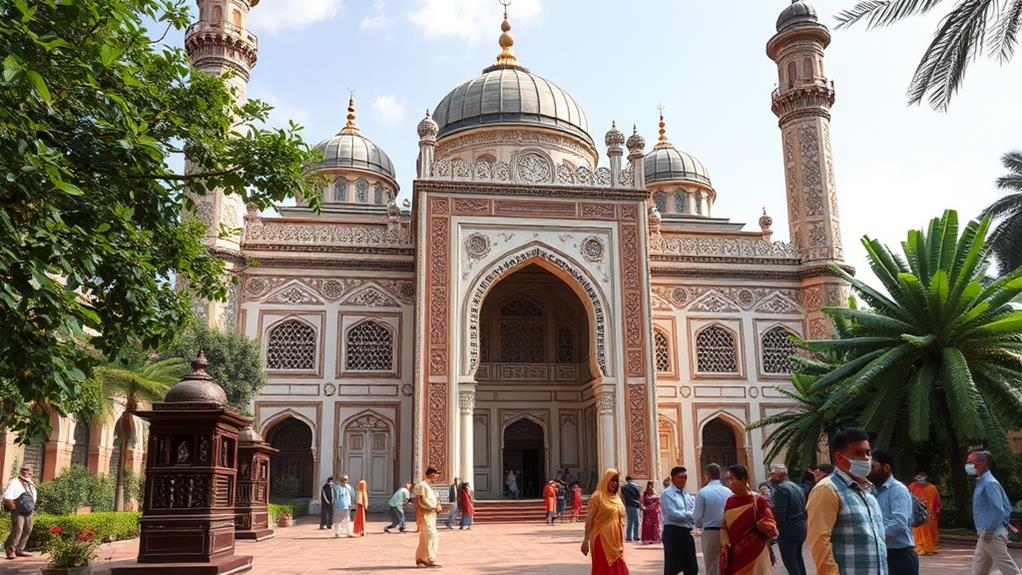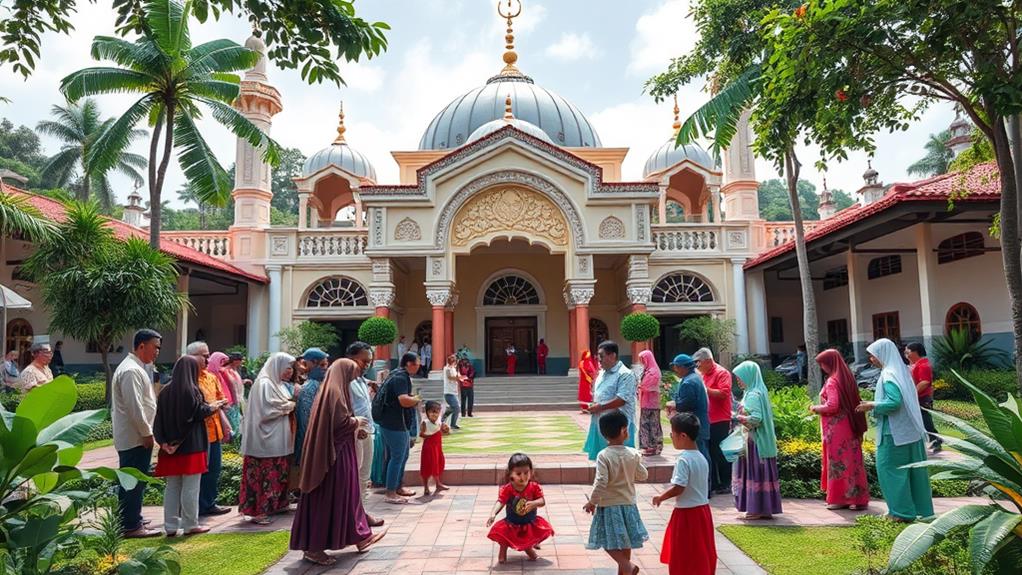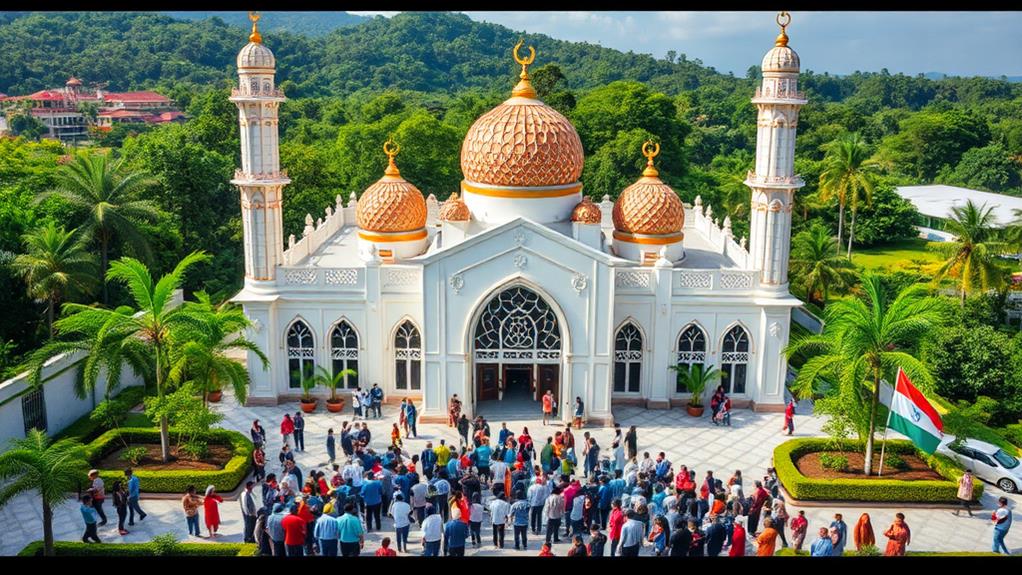Mosques are central to the lives of Filipino Muslims, serving as sacred spaces for daily prayers and community gatherings. For instance, the Grand Mosque in Cotabato and the Pink Mosque are notable examples that symbolize cultural unity and interfaith collaboration.
These architectural marvels offer more than just a place of worship; they provide Quranic studies, fostering a deeper connection to the Islamic faith.
During Ramadan, mosques become vibrant centers of communal spirit, where bonds are strengthened through shared activities and prayers.
Despite challenges, these centers continue to evolve and adapt, remaining essential to the fabric of Filipino Muslim identity.
Understanding the significance of mosques offers rich insights into the broader tapestry of Filipino Muslim life and culture.
Historical Significance of Mosques

Mosques have played a vital role in shaping Filipino Muslim communities and cultural identity for centuries.
The introduction of Islam to the Philippines is marked by the construction of the Sheik Karimol Makhdum Mosque in 1380, which was built by Arab and Gujarati merchants who came to the country through trade. This event laid the foundation for the Islamic faith in the Philippines.
By the 14th century, mosques began to emerge in Mindanao, indicating the acceptance of Islam among local leaders. This led to the formation of the Sultanate of Sulu in 1450, a significant milestone in Muslim governance.
In the Zamboanga region, the Taluksangay Mosque, built in 1885, is a testament to the rich Islamic heritage that thrives in the area.
The Grand Mosque of Cotabato, the largest mosque in the Philippines, can accommodate up to 15,000 worshippers, highlighting the central role of mosques in community gatherings and worship.
Historical mosques, such as Baab ur-Rahman in Taraka, serve as cultural landmarks, reflecting the evolution of Islamic architecture and its enduring importance.
These mosques aren't just places of worship but living testaments to the history and resilience of Muslims in the Philippines.
Architectural Features and Styles
Philippine Mosques: A Blend of Cultural Influences
The architectural features of Philippine mosques reflect a rich cultural heritage, showcasing a unique blend of historical and cultural influences. Minarets, domes, and prayer niches are common architectural elements found in these mosques.
The Grand Mosque in Cotabato City is a prime example, boasting multiple gold domes that can accommodate up to 15,000 worshippers, making it the largest mosque in the Philippines.
In contrast, the Masjid Dimaukom in Maguindanao stands out with its distinctive pink color, a modern twist on traditional mosque architecture.
Cultural influences extend beyond local styles, as seen in the Blue Mosque in Taguig, which draws inspiration from the geometrical patterns of Córdoba, Spain.
The Taviran Pusaka Mosque is another example, showcasing a rare pagoda style, a testament to the remaining architectural forms in the Philippines.
These mosques serve not only as places of worship but also as cultural landmarks, embodying the rich heritage of the Muslim community in Mindanao State and beyond.
Cultural Unity and Community Impact

Mosques Foster Cultural Unity and Social Cohesion
In the Philippines, mosques play a vital role in promoting cultural unity and social cohesion among Filipino Muslims.
The Pink Mosque, built in 2014, exemplifies interfaith unity, having been constructed through the collaborative efforts of Muslims and Christians.
Mosques also serve as cultural melting pots, fostering social cohesion within the Autonomous Region in Muslim Mindanao.
Ditsaan Grand Masjid is a prime example, where Muslims and non-Muslims come together to promote understanding and unity.
The architectural beauty of mosques in the Philippines reflects the diversity of practices among Filipino Muslims.
The Hadja Sitti Raya Mosque in Sulu showcases a blend of various cultural inspirations, highlighting the unique cultural practices of Filipino Muslims.
Furthermore, mosques serve as community gathering places, strengthening bonds among locals.
The Little White Mosque by the Sea in Tawi-Tawi is a humble structure that embodies the simple lifestyle of its residents, hosting community activities that bring people together.
Spiritual Role in Daily Life
The mosque is a central institution in the daily lives of Filipino Muslims. It provides a dedicated space for essential practices like the five daily prayers, or Salat. During each prayer, the qibla, oriented toward the Kaaba in Mecca, serves as a constant reminder of the connection to the global Muslim community.
Throughout Ramadan, the mosque transforms into a vibrant hub for communal prayers and gatherings, creating an atmosphere imbued with shared spirituality. Collective rituals, such as Tarawih prayers, enhance individual devotion as worshippers come together to recite the Quran.
Mosques also offer Quranic studies, allowing individuals to deepen their understanding of Islam in the Philippines and its teachings.
The mosque's design fosters reverence and connection to Allah. The collective experience of prayer fortifies the bonds within the community, reminding individuals that they're part of something greater.
The mosque reinforces faith and sense of belonging, emphasizing the spiritual role it plays in daily life.
How Do Mosques Play a Role in the Islamic Communities in the Philippines?
Mosques play a crucial role in exploring islamic communities philippines. They serve as more than just places of worship, providing a space for community gatherings, education, and social support. Mosques also serve as a symbol of unity and strength within the Filipino Islamic community.
Modern Developments and Recognition

Modern Developments in Philippine Mosque Architecture
Philippine mosque architecture has undergone significant modern developments, blending cultural heritage with contemporary values. The Grand Mosque of Cotabato, the largest mosque in the Philippines, is a prime example of this fusion.
Accommodating up to 15,000 worshippers, its Islamic architectural design combines traditional elements with modern aesthetics, creating a functional and beautiful space.
Another notable example is the Golden Mosque in Quiapo, which features a striking gold dome and stained glass. Commissioned by Imelda Marcos in 1976, this historical landmark attracts both visitors and locals, showcasing the richness of Islamic culture in urban settings.
Promoting Interfaith Unity
In 2014, the Pink Mosque emerged as a symbol of peace and interfaith unity, bridging gaps between Muslims and Christians in the community.
The Ditsaan Grand Masjid serves not only as a place of worship but also as a contemporary cultural center, fostering Islamic teachings and community engagement.
Recognition and Appreciation
Recent travel blogs and articles have highlighted the importance of these Philippine mosques, increasing awareness and appreciation of Islamic heritage throughout the country.
Challenges and Future Directions
Challenges Facing Mosques in the Philippines
Mosques in the Philippines, particularly in Mindanao, face numerous challenges that mirror broader socio-economic issues.
Poverty and underdevelopment are prevalent in many Muslim communities, affecting the infrastructure and resources of these vital community centers. Despite providing essential services, they require more support to enhance educational initiatives and social services for local populations.
Extremist Groups and Interfaith Dialogue
The presence of extremist groups has disrupted peace and security, complicating community efforts to foster understanding and reconciliation.
This highlights the urgent need for interfaith dialogue, as collaboration between Muslim and non-Muslim communities can address misconceptions and promote a more inclusive society.
Future Directions
The establishment of the Bangsamoro Autonomous Region in Muslim Mindanao (BARMM) in 2019 offers a glimmer of hope.
This new political landscape encourages the revitalization of cultural practices within mosques and grants increased autonomy and recognition to Muslim communities.
By leveraging this opportunity, mosques can become even more integral to community life, fostering resilience and unity amidst socio-economic marginalization.
The future direction hinges on collective efforts to strengthen these sacred spaces, ensuring they thrive as centers of faith, culture, and social support.
Questions and Answers
What Role Did Mosques Play in Muslim Culture?
Mosques are central to Muslim culture, serving as spiritual hubs that foster community and faith.
They provide a space for Muslims to connect with their faith and practice their daily prayers. Additionally, mosques act as community gathering spots, hosting various events and activities that promote cultural identity and unity. For instance, mosques often organize events during Ramadan, such as iftars and taraweeh prayers, which bring the community together.
Mosques also function as educational centers, offering knowledge and awareness.
They provide Islamic education to children and adults, teaching them about the Quran, Hadith, and Islamic history. Many mosques also offer lectures, workshops, and seminars on various topics, including Islamic finance, marriage, and parenting.
Mosques serve as social service centers, supporting those in need.
They often provide food, clothing, and shelter to the homeless and needy. Some mosques also offer counseling services, health clinics, and youth programs. For example, many mosques have food banks that distribute food to low-income families and individuals.
The architecture of mosques reflects local traditions and cultural heritage.
Mosques in different regions have unique architectural styles that reflect the local culture. For instance, mosques in the Middle East often feature domes and minarets, while those in Africa may incorporate traditional African designs.
Mosques facilitate interfaith dialogue and bridge gaps between diverse communities.
They provide a platform for people of different faiths to come together, promoting understanding and mutual respect. Many mosques host interfaith events, such as open houses, discussions, and community service projects, which help build relationships between Muslims and non-Muslims.
When Did the Muslims Build the First Mosque in the Philippines?
The first mosque in the Philippines, the Sheikh Karimol Makhdum Mosque, was built in 1380.
This mosque holds great historical significance as it served as a foundation for early Muslim settlements in the country.
Its unique architectural style and design set it apart from other structures of its time.
The mosque became a central gathering place for the local community, where they practiced their faith and celebrated their cultural heritage.
The construction of this mosque marks an important chapter in Filipino history, symbolizing the acceptance of Islam in the region.
What Is the Role of Mosques in American Muslim Life?
In American Muslim life, mosques serve as community hubs, providing spiritual guidance and a sense of belonging.
These gathering spots host educational programs that enrich cultural identity, such as Arabic language classes and Islamic studies, which foster youth engagement and help them connect with their heritage.
Additionally, mosques offer social services, including food banks and counseling, to support those in need.
Through interfaith dialogue, mosques also facilitate conversations with other communities, promoting mutual understanding and respect.
How Did Islam Affect the Philippines?
Islam's influence in the Philippines led to significant cultural integration and historical significance. This integration was fostered through shared spiritual practices and community gatherings, such as the celebration of Eid al-Fitr, which marks the end of Ramadan, and the daily congregational prayers in mosques.
These communal activities promoted social cohesion among Muslim Filipinos.
Educational institutions emerged, promoting Islamic teachings while enhancing local knowledge. For example, the oldest Islamic school in the Philippines, the Jamiatul Philippine Al-Islamia, was established in 1956 and offers a curriculum that combines Islamic studies with modern education.
This blend of education helped to preserve Islamic traditions while promoting cultural understanding.
Islamic principles encouraged trade and collaboration among diverse communities. The Islamic concept of "ummah" (global Muslim community) facilitated trade and commerce between Muslim Filipinos and other Muslim-majority countries.
This led to the exchange of goods, services, and ideas, which contributed to the country's economic growth.